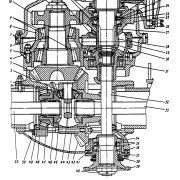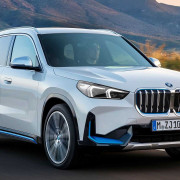Hotcars
Содержание:
1/10 Track-Tuned Performance Features
via Toyota
The 2022 Camry TRD benefits from tangible performance improvement, courtesy of the rack-tuned performance features afforded by the TRD division. The 19-inch matte-black alloy wheels help reduce weight and improve steering response, while the red-painted 12.9-inch diameter ventilated disc brakes with dual-piston calipers provide remarkable stopping power.
via Toyota
The sophisticated sport-tuned MacPherson front strut suspension and multi-link rear suspension deliver the perfect harmony of a smooth and relaxed ride. The underbody braces boast increased thickness for increased torsional rigidity, and unique coil springs drop the Camry TRD .60 inches for a desirably low center of gravity. The specially-tuned cat-back dual exhaust reduces back pressure and helps optimize engine power and efficiency.
The R in TRD
While the TRD enhancements aren’t a huge deal on the road, they really make themselves known once you set up a bunch of cones in a parking lot and start driving between them in anger.
We already know the current Camry is an admirably decent handler (especially in contrast to its predecessors) but the TRD parts make the midsize sedan a genuine entertainer on the autocross. The Camry TRD’s steering felt both lighter, quicker, and less laborious than the XSE. Body movements are a degree sharper; the chassis feels significantly more willing to rotate. By contrast, the XSE feels like somebody took the TRD version and caked a layer of mud all over the running gear.
Toyota Camry XSE and Avalon Touring, Chris Tsui
That TRD/non-TRD gulf is even bigger in the Avalon. Toyota pushed the envelope as far as it could with the new generation to avoid alienating the car’s geriatric buyers, which is to say, not very far. To huck all 3,704 pounds of vanilla Avalon Touring through a tight autocross is to be reminded of the car’s roots as a big ol’ boat. It’s not terrible at parking lot racing, all things considered, but the copious tire squeal and accompanying understeer makes it clear that autocross isn’t its cup of tea.
By contrast, the TRD eliminates those milquetoast manners and feels far more at home being tossed around. You can both hear and feel the brake-based Active Cornering Assist yanking the Avalon TRD into bends, and as a result body control is very much improved.
Toyota Camry TRD and Avalon TRD, Chris Tsui
That said, much of the TRD twins’ autocross competence comes down to the platform itself. Toyota’s new modular car architecture (TNGA) provides an incredibly solid base on which to build, both lighter and more rigid than preceding platforms. The TRD suspension, chassis, and steering enhancements simply iron out the remaining slop while adding a bit of aural flare.
Speaking of, those exhaust notes might just be our favorite part of the whole package. The TRD-designed, K&N-produced catback exhausts on both cars emit a refined, sports car-worthy sound that makes for more pleasurable listening than the racket produced by the 86’s boxer four-cylinder. This might sound insane, but the sound is good enough that you’ll want to roll down the windows in a tunnel and give it the business. Toyota hasn’t messed with either sedan’s interior sound deadening nor have they opted to crudely pipe in any artificial audio through either car’s speakers. Au naturel, baby.
Toyota Camry TRD, Toyota
5/10 An IIHS Top Safety Pick
via Toyota
The Camry TRD has featured in the 2022 IIHS Top Safety Pick list thanks to its extensive range of standard safety features. The Star Safety System encompasses Traction Control, Enhanced Vehicle Stability Control, Electronic Brake-force Distribution, four-wheel Anti-lock Brake System, Smart Stop Technology, and Brake Assist.
via Toyota
Toyota Safety Sense 2.5+ includes driver assist features like Pre Collision System with Pedestrian Detection, Blind Spot Monitor with Rear Cross Traffic Alert, Full-Speed Range Dynamic Radar Cruise Control, Lane Departure Alert with Steering Assist, Lane Tracing Assist, Road Sign Assist, and Automatic High Beams. The Camry TRD also boasts safety features such as Hill Start Assist Control, Rear Seat reminder, Automatic Engine Shut Off, and Tire Pressure Monitor System.
Puttering around on the road like a sane human being, the handling differences between the vanilla cars and their TRD versions are apparent but not exactly night and day. Both the Camry TRD and Avalon TRD retain the standard cars’ cruise-all-day-without-fatigue comfort, yet the overall demeanor is slightly less relaxed. In particular, the Avalon TRD trades the Touring model’s sizeable-by-design on-center dead spot steering for a setup that’s noticeably tighter and more responsive. Likewise, the Camry TRD takes the XSE’s Uber and Lyft-certified compliant ride and unsurprisingly makes it firmer—though not uncomfortably so.
Toyota Camry TRD, Toyota
The TRDs here aren’t quite rowdy enough to earn the cliched «evil twin» title in comparison to their base cars—though perhaps a twin who played more team sports growing up. Same genetics, same bones. Marginally more competitive attitudes.
Toyota Avalon TRD, Toyota
The 2020 Toyota Avalon TRD, By the Numbers
- Base Price: $42,300
- Powertrain: 3.5-liter V6 | 301 horsepower, 267 pound-feet of torque | eight-speed automatic | front-wheel drive
- EPA Fuel Economy: 22 mpg city | 31 mpg highway | 25 mpg combined
- Curb Weight: 3,638 pounds
Toyota Avalon TRD, Toyota
Toyota
Those assuming the Toyota Racing Development-tuned Camry and Avalon would come with more power will be disappointed because, well, they don’t. Instead, the sedans get the same 301-hp 3.5-liter V6 already used in upmarket Camrys and all non-hybrid Avalons. No turbos, just the mainstream soundtrack of a free-breathing six. But the exclusive red-and-black exterior trim pieces aren’t just for show—the cars also gain meatier-sounding catback exhausts and new TRD suspension components including track-tuned coil springs, shock absorbers, stabilizer bars, as well as thicker underbody braces for better torsional stiffness. Lastly, it’s hard to miss that wing planted on the back of the Camry TRD.
Both are lowered 0.6 inches and slapped with front brakes that are nearly an inch larger in diameter than standard. Speaking of braking, pedal feel is tweaked to offer more feedback, and Toyota’s Active Cornering Assist is in play to slow the inside wheel in a corner to combat understeer.
Toyota Camry TRD, Chris Tsui
Lastly, matte-finish 19-inch wheels measure a half-inch wider and cut unsprung weight on the TRD Camry and Avalon by a total of 12.4 and 18 pounds respectively. The success of the cosmetic changes will come down to personal taste; in our eyes, the tuner-esque splitters and spoilers look oddly appropriate given how aggro these two Toyota sedans have already become.
Essentially what we have here is an appearance, exhaust, and handling package. Borrowing from a classic Toyota advertisement, they «have stuff that guys like, like the rims and the sleekness to the body» and should be very «grounded to the ground» indeed. As for the mechanical tweaks, read on.
Toyota Avalon TRD, Toyota
No, They Don’t Come in Beige
Despite what you might’ve assumed, TRD isn’t the most expensive trim for either the Camry or Avalon. At $31,040 for the Camry TRD, it’s actually the cheapest way to get into ‘Yota’s mid-sizer with a V6, while the $42,300 Avalon TRD is essentially the same price as the Touring and almost a grand cheaper than a top-of-the-line Hybrid Limited.
Toyota Avalon TRD, Toyota
With annual production expected to be in the low-four digits for both vehicles, the 2020 Camry TRD and Avalon TRD are more statement cars for Toyota than anything else. By the textbook definition, would a «boring» manufacturer build family sedans that look this racy, sound like junior Jaguars, hold their own on the autocross course, and have seatbelts this red? No. But shaking off a long-held public perception takes more than a few sport-ish sedans, and these two cars likely won’t satisfy the haters. These cars are interesting, even admirable in the face of current market trends, but they’re not groundbreaking or revolutionary in any sense.
Sometimes it really is easy to feel bad for Toyota—but then you remember that it expects to collect a profit of nearly $23 billion this year. The feeling goes away pretty quickly after that.
Toyota Camry TRD, Chris Tsui
6/10 Modernized In-Car Technology
via Toyota
The Camry TRD’s 4.2 -inch TFT Multi-Information Display comes with TRD start-up animation and TRD instrumentation with red-illuminated accents. Along the dashboard sits a seven-inch touchscreen floating display with Apple CarPlay, Android Auto, Amazon Alexa compatibility, SiriusXM, Wi-Fi Connect, and music streaming via Bluetooth wireless technology.
via Toyota
However, Toyota offers an optional nine-inch infotainment with nine JBL speakers, including an amplifier and subwoofer. Other notable in-car technologies include single-zone automatic climate control with air filter, integrated backup camera with projected path, USB media+charging port, USB-C charge port, 12V auxiliary power outlet, Connected Services, and Remote Connect.
9/10 The Cabin Offers Sophisticated TRD Luxury
via Toyota
The TRD treatment converts the standard Camry cabin into a sports sedan interior with the sophisticated luxury expected of a model near the top of the range. The telescopic three-spoke leather-trimmed steering wheel, instrument panel, and shift boot feature red stitching, while the black leather shift knob adds a debossed TRD logo to match the red stitching.
via Toyota
The black Sport SofTex-trimmed seats boast red stitching, fabric inserts, and seat belts, not to mention red-stitched TRD headrest logos and seatback pockets. Similarly, the floor mats in the cabin and trunk have red ‘CAMRY TRD’ logos and the TRD-exclusive red outline.









